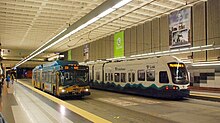Symphony station (Sound Transit)
[3] The area surrounding the station primarily consists of high-rise office buildings and some mixed-use development, providing 102,194 jobs and housing a population of 13,813 within a 1⁄2 mile (0.8 km) of 3rd Avenue and University Street.The university's Board of Regents voted to lease the land to private developers in 1902, beginning a construction boom in the area under the direction of the Metropolitan Building Company.[25][26] In December, Metro agreed to pay $2.4 million to real estate developer Marathon Company for use of a city block they owned adjacent to the station for equipment staging and storage, delaying the planned construction of office buildings on the site.[27] During excavation and construction of the University Street tunnel station, cracks and minor settling were found in the historic Seattle Tower, located nearby.[33][34] In 1994, the Seattle Symphony selected a city block adjacent to University Street station, used during tunnel construction for equipment staging and storage, as the site of their new concert hall.[41] Ownership of the tunnel, including its stations, was transferred to Sound Transit in 2000 but returned two years later to King County Metro under a joint-operations agreement.[54][64] Symphony station was designed in a high-tech motif to complement the modernist architecture found among the 1980s-era office buildings in the adjacent Financial District; architectural elements were used to create the desired atmosphere in the station, including linear stainless steel light fixtures over the platforms, glass railings on the mezzanines, and colorful granite to highlight platform benches and information signs.[68] Both tunnels factored into the architecture of nearby Benaroya Hall, which has an auditorium that rests on rubber bearings to insulate from vibrations and a 6-foot-thick (1.8 m) concrete slab to minimize sound.[65] "The Beltline", designed by Scuri, runs along the platform and consists of colored granite arranged in patterns that highlight passenger amenities, including information panels and benches.[70][71] At the south mezzanine is Robert Teeple's "The Southern Lights", a series of fourteen LED screens that show animated symbols and phrases in a commentary on the increasing influence of computers in human life.The symbols range from human faces to animals and astrological signs;[69] the phrases, displayed in both English and Spanish, are randomly generated from using sets of four words that allow for 1.2 million possible combinations.[65][69] Two of the station's entrances and stairways are home to the silhouettes of and sentence-long quotes from Abraham H. Albertson, architect of the nearby Seattle Tower, and humanitarian activist Flo Ware.[65] The Benaroya Hall entrance to Symphony station, built in 1998 for the new venue, is decorated with a series of art pieces by Erin Shie Palmer known collectively as the "Temple of Music".It was created in 2009 by Christian French as part of the Stellar Connections series and its points represent nearby destinations, including Benaroya Hall, the Seattle Art Museum, the Central Library, and the 5th Avenue Theatre.






Link light railSeattle, WashingtonKing County Metroside platformsSound TransitWestlakeLynnwood City Center1 LinePioneer SquareAngle Lake2 LineDowntown RedmondConvention PlaceBellevue Transit Centerlight railstationDowntown Seattle Transit TunnelSeattleBenaroya Hall1 Linemezzanineshigh-tech architecturepublic artheadwayUniversity of WashingtonDowntown SeattleMetropolitan Tractoffice buildingsmixed-use development1201 Third AvenueWashington MutualSeattle TowerCobb BuildingSeattle Art MuseumSeattle WaterfrontSeattle Aquarium5th Avenue TheatreSeattle Central LibraryRainier SquareUnion SquarePortage BayUniversity DistrictVirgil Boguecomprehensive planrapid transitcivic centerBelltownForward Thrustballot measuresupermajoritybondingUrban Mass Transportation AdministrationMetro Transitdual-mode busbus tunnelcut-and-covertunnel boring machinesWestlake stationequipment stagingsettlingscaffoldingsoft openingdual-mode busestrolleybusesSeattle Symphonyconcert halltransit authorityTukwila International Boulevard stationWashington State Convention CenterConvention Place stationU DistrictNorthgate Link ExtensionLynnwood Link ExtensionSide platformhigh-techmodernist architecturestainless steelgraniteparking garageGreat Northern Tunnelbearingsdot matrixSouth AfricaApartheidastrologicalEnglishSpanishdollar signAbraham H. AlbertsonFlo Warependulum clocknursery rhymeHickory Dickory DockRobert FluddpixellatedBrailleviolinmicrophonepictogramtheater glassesthe artsLynnwoodRainier ValleySeattle–Tacoma International Airportrush hourheadwaysSeaTac/Airport stationbus stopsRapidRideC LineWest SeattleSouth Lake UnionD LineBallardE LineAurora AvenueShorelineFirst Hillspecial routeNorthgateKirklandSODO BuswayRentonInterstate 90BellevueSound Transit Express